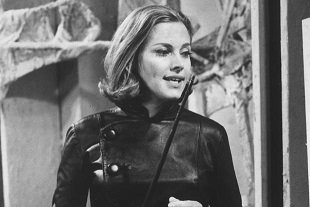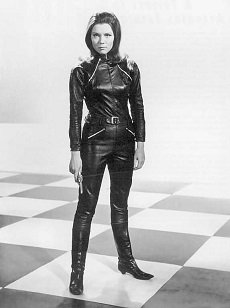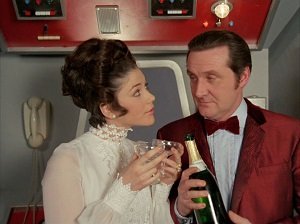Elegance and Grace: Looking Back At The Avengers
It’s odd how one of my favourite TV shows now used to annoy me so much as a kid. At the time, I was a huge fan of Marvel comics, and so when a magazine or the TV would talk about the Avengers, my ears would prick up. When I discovered it was the TV show under discussion, I’d inevitably be disappointed. Odd that nowadays the situation is totally reversed. Captain America, Thor, Iron Man et al are what most people think of when they hear of The Avengers, and the TV show has become a footnote to explain why the movie was called “Avengers Assemble” in the UK. Ironic, then, that nowadays I think I like the TV show more.

I discovered the show on repeat around ten years ago. A late night BBC2 showing of “The Fear Merchants” was my first exposure to the TV show that had floated on the edge of my awareness for years. The episode opens with a man alone in a football field, screaming. It turns out that he is an agoraphobic, and this wide open space has left him mentally destroyed by fear. The agents investigating the incident, John Steed and Emma Peel, are introduced, and I was captivated by the performance of the two actors. At the time I was vaguely aware of Diana Rigg as the Bond girl who was more bad-ass than Bond, but Patrick Macnee was unknown to me. The two had a clear rapport, which witty dialogue fizzing and sparking between them, but it was the motion that captured me. The pair moved as if dancing, not a single wasted motion – a clear visual cue that these were two people who never lost control, who were utterly formidable. The plot of the episode revolved around evil psychologists, using profiling to determine the exact fears that could be exploited to drive someone over the edge and trigger a nervous breakdown. Steed poses as a client, and sets them on Mrs. Peel – in any other show, a reckless move, but here it seems understood that she, like Steed, is fearless. Inevitably, then, two emerge triumphant, while the Fear Merchants are undone through their own phobias. And in the coda, Mrs. Peel discovers Steed’s deepest fear – that they might have run out of champagne.
The episode is honestly not one of the best, but to me it was revelatory. Superspy detectives versus mad scientists – if I had to define the exact type of show to get me hooked, this would be it. I began watching every episode I could get my hands on, though this being before the days of internet downloading, that meant staying up late or taping random episodes from BBC schedule-filler slots. Each one simply whetted my appetite for more. Then while on a trip to the US I discovered a treasure. Sitting in the “British TV” section of Barnes and Noble was a box-set – 17 DVDs in a single slip case. All 51 episodes of the Peel and Steed run of the series. I grabbed it, bought it and somehow found space for it in my luggage. Once home, over the course of weeks, I consumed it. Some episodes were instant favourites, others less so, but overall the experience cemented the show as one of my personal best shows ever. It also meant that, for me, Steed and Peel was the canonical Avengers lineup. Though, as I learned, this wasn’t always the case.

The show began in 1961 as a fairly standard TV thriller show. A doctor named David Keel met a detective named Steed while investigating the murder of his fiancee. Keel was played by Ian Hendry, a rising star who had made a name for himself in the recently cancelled Police Surgeon, where he played the title role. Macnee was much less well known, and didn’t even appear in some of the episodes. This may have been a boon though – while Steed was originally written as a fairly generic private detective (though he actually worked for the government), wearing a trenchcoat and using street slang, and since he was not the focus of the show Macnee was able to put his own stamp on the role. The show’s low budget meant that Macnee supplemented his character’s outfit with items from his own wardrobe, and Steed in a bowler hat with an umbrella soon became the character’s default appearance. When a writer’s strike delayed the second series, and Hendry left to pursue a film career, the show was re-oriented to have Steed as the leading character. His fictional biography began to resemble Macnee’s own – an old Etonian who had been expelled for unbecoming conduct [1] and then enlisted as an officer during World War 2.

The second series also began the tradition of pairing Steed with a female partner. They had Honor Blackman as Cathy Gale, an anthropologist skilled in martial arts, and Julie Stevens as Venus Smith, a nightclub singer. It was Cathy Gale who would prove to be the breakout character that defined the show’s template from then on. Some attribute this to the refocusing of the show – lines which had been written for Doctor Keel were simply transferred to her, giving her a far more assertive role than most female characters at the time. Soon Venus Smith was phased out, and the show became all about the elegant Steed and the intelligent Gale, both shown as physically competent characters able to hold their own in a fight. It was unlike anything on television at the time, and the show seemed poised on the edge of huge success. And then Honor Blackman quit. She had received an offer to star as Pussy Galore in Goldfinger, and so her abandonment of TV was understandable, but it came just as the TV show had closed a deal with ABC to start screening the series in America. They needed a replacement, and she needed to be perfect. Their first choice was a British actress named Elizabeth Shephard, but after filming one episode they decided that she was a poor fit for the role, and made the risky decision to recast the role. They chose a theatrical actress from the Royal Shakespearian Company named Diana Rigg, and it proved to be one of the best decisions they ever made.

The episode that had been filmed with Shepherd was hastily re-edited to include Rigg instead. No introduction was given to the character – instead Steed rings a doorbell, with a card reading “Mrs Emma Peel” below it. The camera pans over to a door decorated with a large carved eye, which flaps open to reveal a camera. Steed enters, to find Emma practicing her fencing moves. After a little discussion the two begin to spar, and they prove to be fairly evenly matched until Steed manages to tangle her up in the curtains, with the observation that he never promised to fight fair. The two are soon off to investigate “The Town of No Return”, a village in Norfolk that appears to have cut itself off from the rest of the world. The two soon discover that the village has been taken over by “a foreign power”, and an underground base there is being used to stage an invasion. Naturally, Peel and Steed save the day.
Rigg was a hit, and the two went on to tackle enemy spies, mad scientists and even the occasional alien invasion over the next two years. Though there was no “series arc” in the modern sense, there was a definite continuity. Some episodes would reveal details of character’s backstories, such as Steed’s World War 2 service (revealed through a plot to hypnotise the attendees at his Army reunion) or Mrs Peel having inherited her father’s electronics company (revealed through a disgruntled ex-employee trapping her in a shifting automated maze, in revenge for firing him years earlier). The fifth series, the second with Mrs Peel, was the first to be filmed in colour – a rarity in 1967. The guest list was like a Who’s Who of British stardom at the time – Peter Cushing, Julian Glover, Christopher Lee, Barbara Shelley, Peter Wyngarde – the list goes on.

Eventually, like Honor Blackman before her, the lure of Hollywood proved too much for Diana Rigg. [2] She left the show on good terms, appearing in the first episode of the sixth season to pass on the torch to Linda Thorson. Thorson’s character, Tara King, was a break from the previous assertive heroines, playing a much more conventional female sidekick. Internal problems plagued the production – the producers for seasons 4 and 5 had been replaced with the producer of season 3, but after running well over budget to produce three lacklustre episodes he was fired and they were brought back. While the 6th season was an extraordinarily long one (33 episodes in total), it was the last of the original series. Towards the end they accepted that the writing was on the wall, and the show descended into self parody and became even more of a romp. In the final scene, a kit-built rocket sends Tara King and John Steed into orbit, in a final moment of silliness.
Of course, it didn’t quite end there. A repeat of the show in France in 1975 (and an advert for champagne in which Macnee and Thorson appeared in character) proved popular enough to raise the funds for a relaunch. In this, “The New Avengers”, Steed played the role of mentor to two new agents, Mike Gambit (played by Gareth Hunt), and Purdey (played by Joanna Lumley). The series was a deliberately more straightforward spy series than the original, as it was felt there was no way to top the silliness of the Tara King series. Two series were produced, though the show was constantly in financial difficulties, and though a third series was planned for it was never made. The show did enjoy a brief resurge in popularity in the mid 90s, however, when it was released on video, and in 1995 it was repeated on the BBC. In fact, it was watching the New Avengers (and being profoundly unimpressed) that led to my not watching the original series for so long. As such, it’s hard for me to get past that and see it on its own merits.
The original Avengers was in many ways both ahead of its time, and deeply old-fashioned. Amid gritty dramas it stood out as a stylised, elegant counterpoint – totally unique [3], and totally unmissable. Even today, rewatching one of these episodes, I feel transported back to a better time that never existed, where champagne, good coffee and companionship are all one needs for the gumption to stand against the strange. Peel and Steed, elegant and better than human, moving like they were dancing through the world.
[1] In Macnee’s case, for selling pornography. In Steed’s, for getting in a fight with the school bully – a Scottish oik named James Bond.
[2] Rigg would also go on to be a Bond girl – in fact, the best Bond girl. This is provable with science.
[3] I am technically aware that a movie was made in 1998 that purported to be based on the show. But as long as I never watch it, it doesn’t have to be real to me. I’m pretty sure that’s how that works.

